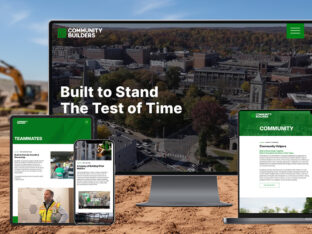
Community Builders: A Legacy Rebuilt for the Future
A veteran-led construction firm with deep community roots gets a revitalized brand system.
read more
Web design and web development are commonly interchangeable terms, at least in the minds of corporate clients. Whether you were speaking about a true web design exercise, with custom branding, colors, typography, user interface, and graphic library (photography, video, animation, etc.), or a literal website development project with information architecture, code writing, technical specifications, software development, content management system creation, etc., the process of approaching a new website project will go much more smoothly if you pay attention to certain critical considerations.
The following list is a well-rounded assembly of such considerations, although there may be other factors that are regarded as equally (or even more) essential, depending on who is doing the work.
With just about any project that Splendor Design takes on, the planning phase is always one of the most important. With any website development project, we start with asking important questions of the client, typically in the form of a questionnaire/survey. This helps gather important information, albeit primarily opinion-based and subjective, that we are unlikely to uncover in a competitive analysis.
On that note, looking at similar companies and organizations in the same business category can shed light on who is doing what, and how we can approach the project from a bit of a different perspective. Our New Jersey web design agency is in a very densely populated, and therefore highly competitive market. This makes it all the more critical for us to think strategically about a unique approach for each of our clients.
With the proper research in hand, we can interpret and formulate a plan for the website design project that will guide each stage of the entire process. A clear road map like this is extremely beneficial and can reduce inefficiencies and the possibility of needing to go back and re-work sections either in the design, programming or page production phases.
Splendor design has built a solid reputation for high-end, sophisticated layout and design in website design projects (and just about all other formats and mediums). This doesn’t happen by accident. We take a very strategic approach to the entire process, and the visual design is no exception.
From brand standards to interactive elements, usability, page flow and navigation, and ultimately delivering users to the content and calls-to-action that are important to them, designing with user experience as the primary focus is very important in our overall process period
The same is true for managing the website content. Although all of our design and web development is custom (no templates off-the-shelf), we do use the WordPress content management system as the foundation of most of our sites.
The reason we like working with WordPress, quite frankly, is that our clients like working with WordPress! This is easy-to-use CMS provides a very robust and scalable set of tools upon which we can build just about any type of functionality. What’s more, we engineer and design the backend management tools to be extremely user-friendly for the client.
By providing page-specific controls with custom fields for all of the different content types, our clients are able to create, add, edit, and delete pages and content with a seamless, intuitive process and experience.
A very high percentage of the web development that we do is based on the WordPress CMS and existing plug-ins. There are a handful of third-party plug-ins that we rely on very heavily: Gravity Forms, Advanced Custom Fields, Yoast SEO, Modern Tribe Event Calendar, and several others.
These plug-ins allow us to quickly build up pages that are easily customizable, create a simple and intuitive backend interface for our clients, and optimize our web design projects on a number of different levels. Without these plug-ins, it would be extremely labor-intensive and costly to build the same functionality from scratch.
There are plenty of situations however, where no matter how we twist and squeeze an existing piece of tech, it just won’t fit our needs. In those cases, creating custom features for tech ensures that they function exactly the way we needed to, and that we are not left with thousands of lines of unnecessary code in the system when we really only needed a small piece of functionality.
In almost every web development project, we try to leverage resources like Cloudflare. This system provides tremendous tools for optimizing websites. From asset caching to optimizing DNS, Cloudflare is a suite of tools that speeds up your website design performance.
1. Code minifying – Cloudflare’s system removes unnecessary code and characters from CSS, JavaScript, and HTML files within a web design project
2. Image optimization – large images can cause websites to load extremely slowly and as a result, ranked poorly in search engine results. Cloudflare’s system creates varieties of images, resizes them, and optimizes them for different devices
3. Browser insights – knowing how well your website is performing is critical. Identifying bottlenecks and issues is something that Cloudflare can help expedite and make quick work of
On the topic of search engine performance and visibility, how quickly a website development project loads in the browser plays a huge role in how well you will rank in the search engine results pages (SERPs). Ensuring that the website loads quickly will greatly enhance your web design value in the eyes of search engines like Google.
On top of the website speed, how well-optimized your pages are also plays a big part in your searchability. As mentioned above, we leverage a tool called Yoast SEO for WordPress. This provides a rudimentary, simple tool to help optimize the website design overall, as well as individual pages. During our web development processes, we look at metadata, image alt tags, code structure and elements, and many other factors on-page to give us the best chance at a seamless indexing process and high resulting page rank.
Nowadays, there are an abundant array of choices among hosting providers. Everything from $5 a month for simple, shared hosting to dedicated servers with custom configurations that can run into the thousands of dollars per month. Obviously, it all depends on your web design project needs. Splendor Design, for example, designs and builds custom websites for many small businesses in New Jersey, and most of them have very simple hosting requirements. A shared hosting option meets those requirements just fine.
Other clients have rich, database driven portals with third party integrations and heavy processing that takes place on a daily or even hourly basis. Evaluating the site’s functional and technical requirements upfront will help you plan for the optimal hosting platform.
There are several hosting providers that we have used over the years. One of the relatively newer emerging categories of website hosting are the managed WordPress hosting providers, such as Flywheel or WP Engine. These providers are dedicated to tight security, speed optimization, and optimized caching – all for WordPress websites specifically.
We have had some pretty negative experiences with the lower and shared hosting providers. But some of the more robust and powerful (and expensive) hosting options are potentially overkill and unnecessary. GoDaddy.com offers a solution in between these two extremes. Their Business Hosting Packages are certainly more expensive that typical shared hosting, but offer many of the same “dedicated resources” that a virtual private server (VPS) or dedicated server would offer you. These plans are definite worth looking into.
During the website development process, planning for asset storage ahead of time can alleviate issues in the future. Especially for a media-intensive websites with large imagery, multiple galleries, video, etc., file storage quotas can be gobbled up pretty quickly.
AWS (Amazon Web Services) offers some interesting options for delivering your content. There are other options for storage as well, but again, trying to size up the requirements ahead of time can save you the hassle of migrating to a larger, more accommodating server in the future.
When your asset library is large, it may also make sense to archive specific media that is not currently being used. There are systems and plug-ins available that enable relatively easy file backups and even snapshot backups of an entire website instances. These backup files can be saved to Google Drive, Dropbox, and a host of other storage options.
Once the website design and web development processes are complete and the site is ready to launch, it is important to have a plan for maintaining the website going forward, and keeping everything up-to-date and secure.
The number one vulnerability along website development projects is outdated software. Plug-ins, core software, and even operating system versions can go out of date and increase the likelihood that a vulnerability may exist. Keeping the site safe, secure, and up-to-date is critical to minimizing your exposure.
For Splendor Design, the entire website design and website development process involves a large number of moving parts, phases, teams, and extensive expertise. Having a solid understanding of the most critical steps in the overall span of the project is what helps our projects succeed. Overlooking a few, or even just one, of these important considerations can derail a web development project quickly.
Plan ahead, pay attention to the details, and anticipate success.

Splendor believes an educated client is our best client. Stay tuned to our blog for insight into the world of everything design, web, and digital media. Have something to add? Connect with us on social media – we’d love to hear from you.
Connect with Adam on LinkedIn to see his latest articles and tips in all things business and marketing!

A veteran-led construction firm with deep community roots gets a revitalized brand system.
read more
Splendor refreshed Erika’s visual identity and messaging to elevate a trusted name in bakery equipment.
read more
Discover how our team gave Index Engines a powerful new identity through strategy and bold design.
read more